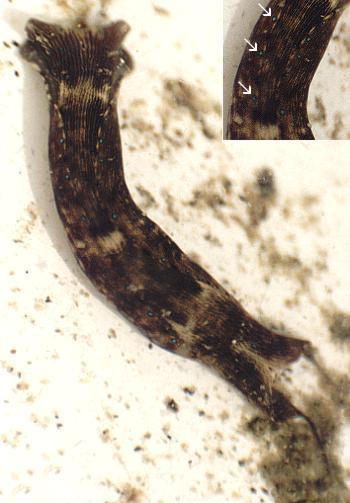
Navanax aenigmaticus
(Bergh, 1893)
Order: CEPHALASPIDEA
Superfamily: PHILINOIDEA
Family: Aglajidae
DISTRIBUTION
Pacific Coast of Central America (sthn Mexico to Peru), Caribbean Sea, Atlantic coast of Sth America from Caribbean to Brazil. Possibly west Africa.
PHOTO
Santa Marta, Colombia. Length 1.5 - 2 cm. Photo: Phanor Montoya. Inset showing blue spots (arrows) along parapodial edge.
Originally described from the Pacific coast of Panama, Pacific animals are usually brown with whitish blotches and bright blue spots along the inner parapodial border but occasionally a specimen with brown and white lines is found. In the Caribbean the animal is usually lined with white and brown as in this photo from Colombia. This colour form was described as a distinct species Chelidonura evelinae Marcus, 1955. Gosliner (1980) also considered species described from West Africa to be synonyms. Humann (1992) reports that it feeds on other opisthobranchs and in particular Elysia crispata.
Reference:
• Gosliner, T.M. (1980) Systematics and phylogeny of the Aglajidae (opisthobranchia: Mollusca). Zoological Journal of the Linnean Society, 68(4): 325-360.
• Marcus, Er. (1955) Opisthobranchia from Brazil. Boletim da Faculdade de Filosofia, Ciencias e Letras. Universidade de Sao Paulo, Zoologia, 20: 89-261. (Pls. 1-30)
Rudman, W.B., 2000 (October 2) Navanax aenigmaticus (Bergh, 1893). [In] Sea Slug Forum. Australian Museum, Sydney. Available from http://www.seaslugforum.net/find/navaaeni
Related messages
The strange Chilean 'sinistrobranch' Posterobranchaea
March 15, 2007
From: Michael Schroedl
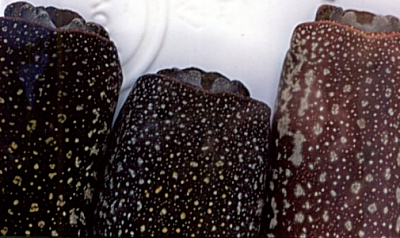
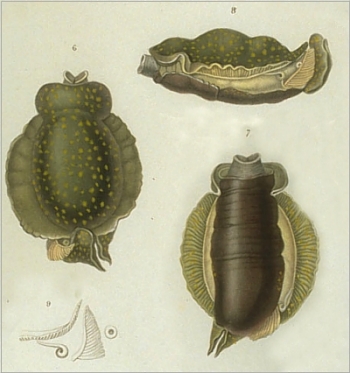
Following on from my messages about Navanax aenigmaticus [#19659, #19658] here is some background information about a puzzling animal from Chile which may be the same species.
There seems to be only one historic record of a cephalaspidean from Chile which lacks an external shell. D'Orbigny (1835-46) described the "bizarre" Posterobranchaea maculata new genus, new species from a few, or perhaps just a single specimen, dredged from muddy sand at a depth of nearly 30 m; off Valparaiso. The specimen was 3 cm long but quite wide (2 cm), and the original drawings indicate the body was somewhat contracted. D'Orbigny ( pages 201-203) emphasized the "unique" left-sided position of a posterior gill, anus, genital organs and opening (figs. 6-10), leading him to establish a new higher group, Sinistrobranchia, to distinguish it from all other tectibranchs which have these organs and openings on the right side. Further "anomalies" of P. maculata included a "foot" that is transversally divided into two portions, the larger posterior portion forming a bifid tail, and a pleurobranchid-like large "mantle" with a wide brim except at its most anterior. From a modern perspective it is funny to follow D'Orbigny's explanations and reasoning, since he just had to turn his specimen over, so it was the right way up, to resolve all his problems and obtain a normal aglajid sea slug. He obviously was not aware of the externally similar Mediterranean Aglaja tricolorata Renier, 1807 (or its synonym Doridium membranaceum Meckel, 1809). It was not until later that the bulk of aglajid species were discovered and described.
Rudman (1974) related the central Chilean Posterobranchaea maculata to the Aglajidae, with unknown generic position. The closest record of an aglajid to Valparaíso was the Panamic Navanax aenigmaticus. Gosliner (1980, 1991) feared that P. maculata could be a senior synonym of Navanax aenigmaticus and if so, it would mean that the older generic name Posterobranchaea D'Orbigny, 1837 would have priority over the established Navanax Pilsbry, 1895. Our finding of N. aenigmaticus near Antofagasta, Chile, reduces the distance to Valparaíso to hardly 750 km. More important, N. aenigmaticus is obviously able to inhabit places within the cool Humboldt Current system.
Does P. maculata actually refer to N. aenigmaticus? Opisthobranch illustrations given in D'Orbigny's atlas are not always quite realistic (see Schrödl, 2003). There is no eastern Pacific opisthobranch that would match the drawings of P. maculata [see middle photo - d'Orbigny, Pl 17, figs 6-9] accurately. As reflected by the specific name, the greenish brown foot (as "mantle") has irregular "beautiful sulphur-yellow" spots along the sole; this fits with two of three specimens of N. aenigmaticus found at the northern Chilean Juán López showing yellow spots on the foot sole and whitish spots more laterally; the third one has whitish spots only [see upper photo, and message #19659]. The outer parapodial areas and sides of the body are more brightly coloured than in d'Orbigny's illustrations. D'Orbigny described the head shield and notum (his "divided foot") as entirely blackish brown. However, the drawings (figs. 7, 8) show soome marginal yellow spots or marbling. All specimens from Juán López showed at least some whitish patches on head shield, visceral shield and lobes; however, one specimen was nearly completely blackish brown. D'Orbigny considered the terminal lobes as part of the "foot", but gave them the colour of what he thought was the mantle. D'Orbigny did neither mention nor does the drawing indicate the presence of blue parapodial spots. In conclusion, it is still not proven but more than likely that Posterobranchaea maculata refers to Navanax aenigmaticus, which then would be the single aglajid known from the south-eastern Pacific and would need nomenclatural protection.
-
D'Orbigny, A. 1835-1846. Voyage dans l'Amérique Méridionale exécuté pendant les années 1826-1833. Vol. 5. Mollusques. Libraire de la Société geologique de France:
-
Gosliner, T.M. 1980. Systematics and phylogeny of the Aglajidae (Opisthobranchia: Mollusca). Zool. J. Linn. Soc., 68: 325-360.
-
Gosliner, T.M. 1991. The opisthobranch gastropod fauna of the Galápagos Islands. [In:] Topics in Geobiology, Vol. 8. Galapagos marine invertebrates: taxonomy, biogeography, and evolution in Darwin's islands (James, M.J., ed.). Xiv + 474 pp. Plenum Press, New York, London.
-
Rudman, W.B. 1974. A comparison of Chelidonura, Navanax and Aglaja with other genera of the Aglajidae (Opisthobranchia: Gastropoda). Zool. J. Linn. Soc., 54: 185-212.
-
Schrödl, M. 2003. Sea slugs of southern South America. Conchbooks, Hackenheim. 165 pp.
Michael Schrödl
schroedl@zi.biologie.uni-muenchen.de
Schroedl, M., 2007 (Mar 15) The strange Chilean 'sinistrobranch' Posterobranchaea. [Message in] Sea Slug Forum. Australian Museum, Sydney. Available from http://www.seaslugforum.net/find/19660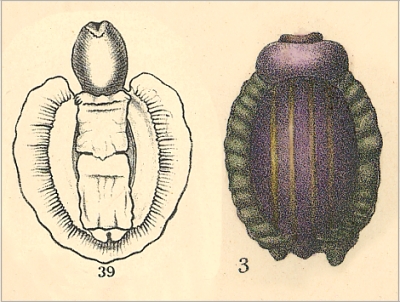
Dear Michael,
I like a good detective story. Many of these old names raises the question of just how much of the very old literature and old names we should protect? In this case bergh's description of N. aenigmaticus is probably no better than d'Orbigny's description of P. maculata I guess the debate over whether the 'oldest name' should remain sancrosanct at all costs will always be with us.
I've included a couple more relevant old illustrations. They don't solve anything but thought they were part of the story. Both are from Pilsbry's 1896 volume, a great resource for copies of even older illustrations.
FIGURE: Left: Navarchus aenigmaticus Bergh, 1893 [from Pilsbry, 1896: Pl. 6, fig. 39. Right: Posterobranchaea orbignyana Rochebrune, 1881 [from Pilsbry, 1896: Pl. 54, fig 3]
It is interesting to compare d'Orbigny's illustrations of his species with Bergh's illustration of the preserved specimen of N. aenigmaticus on which he based the species [left]. In his specimen the buccal bulb has popped out of the body, but apart from that it could be the same animal - or quite a few other aglajids I guess. I noticed that Gosliner (1980) mentioned another species Posterobranchaea orbignyana which he said was based on a specimen also from northern Chile, and it had yellow lines. On checking I find it reported not from Santiago in Chile, but Santiago Island in the Cape Verde Islands in the East Atlantic. I have no idea what it is, but it would be a strange coincidence if it turned out to be Edmunds C. nyanyana from Ghana, which we think is probably N. aenigmaticus. As Gosliner notes, two other names from the Caribbean, Doridium gemmatum Morch, 1863 and Doridium punctilucens Bergh, 1893 with black lines and green spots could well apply to the typical Caribbean colour form of N. aenigmaticus. It seems to me that the only way to protect the genus name Navanax and the species name N. aenigmaticus is for someone to prepare a submission to the International Commission. The question of what to call the Atlantic form can only be resolved after a decision is reached on whether it is the same species as the East Pacific species or not.
- Pilsbry, H.A. (1896) Manual of Conchology; Structural and Systematic with Illustrations of the Species. [Ed: G.W.Tryon] Vol. 16, 251pp, Pls 1-71.
- Rochebrune, A.T. (1881) Matériaux pour la faune de l'Archipel du Cap Vert. Nouvelle Archives du Museum National d'Histoire Naturelle, Paris, series 2, 4: 215-340, pls. 17-19.
- Rochebrune, A. T. (1882) Diagnoses d'espèces nouvelles pour la faune de l'Archipel du Cap-Vert. Bulletin de la Société Philomathique de Paris, series 7, 6: 24-32.
Best wishes,
Bill Rudman
Chilean Navanax aenigmaticus
March 14, 2007
From: Michael Schroedl
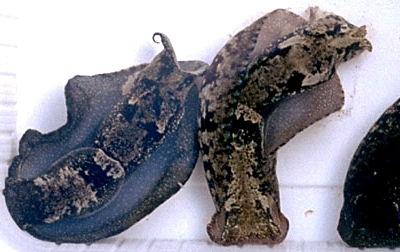
I have collected opisthobranchs along the continental coast of Chile for several years. In that time I have only once found an aglajid species, and that was at Juan López, near Antofagasta, northern Chile, on 26 February 1994. Three large specimens (8.5-10 cm; photograph attached) were crawling around openly during daytime, and were more or less easily visible between algae on rocks and on the sandy bottom of a protected bay at 3-5 m depth. Water temperature was exceptionally high (21°C) there. On 17 March 1994 we found another individual in the same bay, however, at temperatures of 16° C which was still higher than temperatures we measured at other places along the central and northern Chilean coast in March 1994.
Their body shows a head shield with rounded posterior border, bifid posterior lobes and large parapodia. The ground coloration of head shield, visceral shield and ventral parapodia varies from reddish brown to very dark brown and is more or less extensively mottled with white, except for the foot sole area which shows whitish or yellow dots. The dorsal portion of parapodia is brighter and looks faded, with whitish dots. All specimens show a characteristic row of small blue spots along the parapodial margin, thus leaving little doubt that they are Navanax aenigmaticus.
This present record extends the Pacific range of N. aenigmaticus from tropical Panamic waters and Galapagos (see Behrens & Hermosillo, 2005) far south into the temperate Humboldt Current system. In the absence of adequate surveys it cannot be decided yet whether N. aenigmaticus is a regular member of the Chilean fauna occurring at least at locations with special environmental conditions, or just a sporadic guest. Growing up to 10 cm in length, eastern Pacific N. aenigmaticus may grow considerably larger and more bulky than supposedly conspecific Caribbean specimens (up to 5 cm according to Valdés et al., 2006), and do not seem to show the longitudinal notal and parapodial stripes which are at least usually present in Atlantic individuals. It would be worth investigating whether or not such differences are true and consistent in such geographically clearly defined and separated populations. Whatever its taxonomic implications, we would expect at least a certain degree of divergence had evolved during the last roughly 3 million years. The rise of the Isthmus of Panama is an evolutionary experiment designed by nature which, regarding opisthobranchs, still waits for somebody performing (also molecular) analyses.
-
Behrens, D.W. & A. Hermosillo. 2005. Eastern Pacific nudibranchs. Sea Challengers, Monterey. 137 pp.
-
Valdés, À, Hamann, J., Behrens, D.W. & A. DuPont. 2006. Caribbean sea slugs. Sea Challengers, Gig Harbour. 289 pp.
Michael Schrödl
schroedl@zi.biologie.uni-muenchen.de
Schroedl, M., 2007 (Mar 14) Chilean Navanax aenigmaticus. [Message in] Sea Slug Forum. Australian Museum, Sydney. Available from http://www.seaslugforum.net/find/19659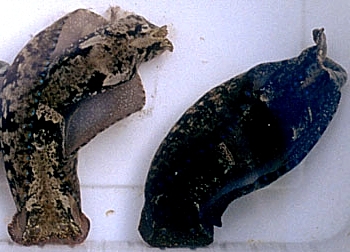
Dear Michael,
Thanks for this interesting record. Certainly the records of this species from the Eastern Pacific on the Forum, lack the longitudinal lines which normally occur in Atlantic specimens, but there is at least one example from the Caribbean [message #11126] of an animal without lines. However the pattern of dark blotches is quite consistent from both oceans. It reminds be of colour variability in Chromodoris striatella . For those of you who aren't familiar with Navanax aenigmaticus, it was originally described from the Pacific coast of Panama, so if future studies show the Atlantic form to be distinct, then there are a number of names, such as Navanax evelinae (Marcus, 1955), which are available.
Best wishes,
Bill Rudman
West African Navanax aenigmaticus
March 14, 2007
From: M. Schroedl, P. Ryall, T. Gertin, T. Neusser
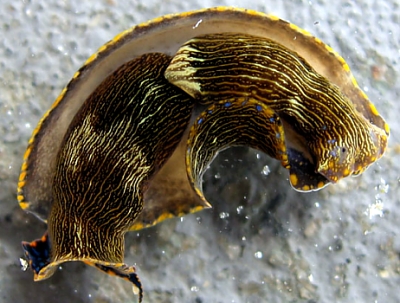
Hi Bill,
Here are some pics of living specimens of what Edmunds (1968) described as Chelidonura nyanyana from the Ghana coast near Accra. We found them some 250 km more to the southwest, along the rocky capes around Princesstown. One specimen (5 cm) was crawling in a tide pool, another smaller one (3.5 cm) was found under a stone at 5m depth. Quite similar to what is Navanax aenigmaticus in Chile and Peru, but I've never seen such yellow or orange markings along the parapodia border in specimens from there [message #19659 ]. Nestor Ardila's small Caribbean specimen, however, may show such markings. Might N. aenigmaticus occur in the eastern Atlantic as well?
-
Edmunds, M. 1968. Opisthobranchiate Mollusca from Ghana. Proc. Malac. Soc. Lond., 38: 83-100.
Michael Schrödl, Peter Ryall, Ted Gertin, Timea Neusser
schroedl@zi.biologie.uni-muenchen.de
Schroedl, M., Ryall, P., Gertin, T., Neusser, T., 2007 (Mar 14) West African Navanax aenigmaticus. [Message in] Sea Slug Forum. Australian Museum, Sydney. Available from http://www.seaslugforum.net/find/19658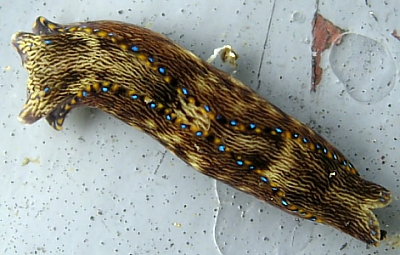
Dear Michael,
Terry Gosliner considered Malcolm Edmund's C. nyanyana to be the same as N. aenigmaticus and your photos certainly support that view. Certainly from messages on the Forum, most Caribbean specimens have blue and yellow spots along the mantle edge.
-
Gosliner, T. M. (1980) Systematics and phylogeny of the Aglajidae (Opisthobranchia: Mollusca). Zoological Journal of the Linnean Society, 68: 325-360.
Best wishes,
Bill Rudman
Navanax aenigmaticus from Brazil
June 14, 2005
From: Wagner Torres
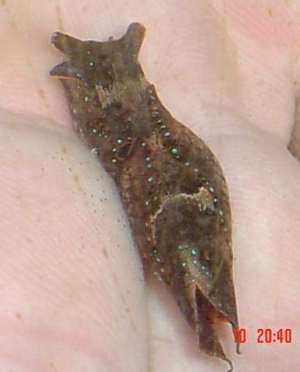
Dear Bill,
Here is another opisthobranch from Brazil. I don't know if this animal with blue spots (small iridescent blue ring) is a Stylocheilus longicauda (maybe???)
I noticed it in my reef tank on the glass. I'd like to know what they are? I cannot identify!!
Can you help me? Thanks very much and kind regards from Brasil - And excuse my bad English
Best wishes,
Wagner Torres
wtorres@urbi.com.br
Torres, W., 2005 (Jun 14) Navanax aenigmaticus from Brazil. [Message in] Sea Slug Forum. Australian Museum, Sydney. Available from http://www.seaslugforum.net/find/14053Dear Wagner,
Don't worry about the bad English. This is Navanax aenigmaticus. It has not been recorded from Brasil under that name, but Ernst Marcus described a species Chelidonura evelinae from Sao Paulo [Marcus, 1955] which is surely the same. We have a tentative record from Rio de Janeiro in an earlier message [#11327] so its good to get a photo to confirm the find. I would appreciate any information on where the animal could have come from.
Best wishes
Bill Rudman
Navanax aenigmaticus from Brazil
November 15, 2003
From: Vinicius Anderson
Hi Bill,
I collected one specimen of sea slug last week there I think is Navanax aenigmaticus because there are very similar animal photos on the Navanax aenigmaticus page. The animal was collected in Conchas Beach, Cabo Frio, Rio de Janeiro, Brasil. (Unfortunately I haven´t any photo of this animal)
Has this species been recorded in my country? Can I confuse Navanax aenigmaticus with another similar species?
Thank you,
Vinicius Anderson
viniciusanderson@hotmail.com
Anderson, V., 2003 (Nov 15) Navanax aenigmaticus from Brazil. [Message in] Sea Slug Forum. Australian Museum, Sydney. Available from http://www.seaslugforum.net/find/11327Dear Vinicius,
Navanax aenigmaticus has not been recorded from Brasil under that name but Ernst Marcus described a species Chelidonura evelinae from Sao Paulo [Marcus, 1955) which is clearly the same species. So I guess if its in Sao Paulo it would not be surprising to find it also in Rio de Janeiro.
If you animal is similar in shape and colour to the animals in the Forum then I think you can be fairly certain that you have correctly identified it.
• Marcus, Er. (1955) Opisthobranchia from Brazil. Boletim da Faculdade de Filosofia, Ciencias e Letras. Universidade de Sao Paulo, Zoologia, 20: 89-261. (Pls. 1-30)
Best wishes
Bill Rudman
Navanax aenigmaticus from Jamaica
October 18, 2003
From: Ross W. Gundersen
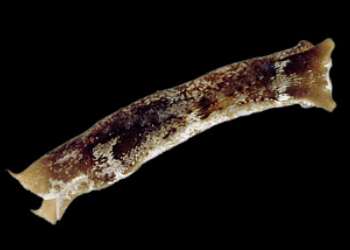
Dear Bill:
Here is another sea slug from Jamaica. As I said in my first message, all specimens were collected from St. Ann's Bay, Jamaica, West Indies. Most specimens were collected using a light weight dredge and photographed by R. Gundersen.
Here is Navanax aenigmaticus. Dredged at 5 m depth in Thallassia. Blue spots extremely variable and may even be absent. Their favourite prey is Elysia crispata.
Best wishes,
Ross
ross.gundersen@uwp.edu
Gundersen, R.W., 2003 (Oct 18) Navanax aenigmaticus from Jamaica. [Message in] Sea Slug Forum. Australian Museum, Sydney. Available from http://www.seaslugforum.net/find/11126Thanks Ross,
It's interesting to know about their liking for Elysia crisaata. Most mollusc-eating aglajids seem to prefer cephalaspidean bubble-shells, so this is an unusual food preference. It confirms Humann's (1992) report.
Best wishes
Bill Rudman
Navanax aenigmaticus from Caribbean
March 5, 2003
From: Nestor E. Ardila
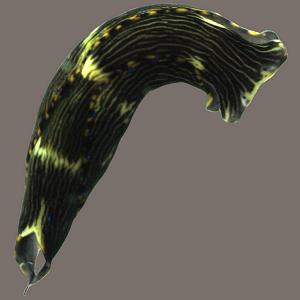
Dear Bill,
Here is a photo of a specimen of Navanax aenigmaticus which was collected manually, in Santa Marta (rocky shore), Colombia, Caribbean coast. It was 7-8 mm long alive. What do you think about the coloration, this is a little different? Probably because this one is a juvenile?
Thanks in advance,
Nestor
nardila@invemar.org.co
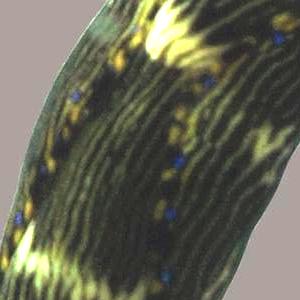
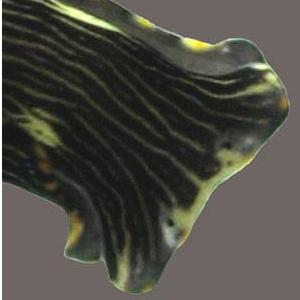
Dear Nestor,
I guess this species is quite variable in colour. The blue spots along the edge of the parapodia and the 3 or 4 transverse whitish bands across the body seem to be fairly constant characters. However I have only seen this species from a few photos so I am not an expert on its colour variation
Best wishes,
Bill Rudman
'Aglaja evelinae' from Belize
October 11, 2002
From: Dave Behrens
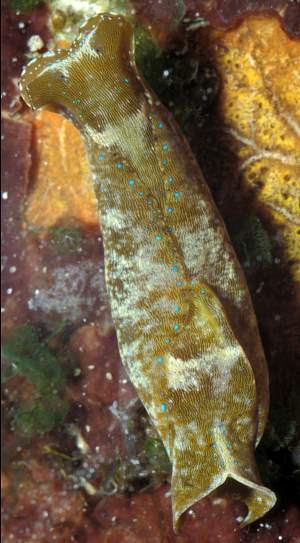
Bill,
Here is another Caribbean critter. We have called this Aglaja evelinae. Humann lists it as Navanax aenigmaticus, which Gosliner (1980)
reported resides on both sides of Panama. Is A. evelinae a junior synonym? Photo from Ranguana Cay, Belize, by Jeff Hamann.
Dave Behrens
dave@seachallengers.com
Behrens, D., 2002 (Oct 11) 'Aglaja evelinae' from Belize. [Message in] Sea Slug Forum. Australian Museum, Sydney. Available from http://www.seaslugforum.net/find/8152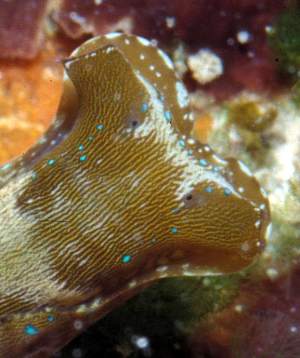
Thanks Dave & Jeff,
Terry Gosliner (1980) decided there were no anatomical reasons to separate Aglaja evelinae from the Caribbean from Navanax aenigmaticus from the east Pacific coast. Certainly the photos we have on the Forum from the Caribbean coast of Colombia and the Pacific coast of Costa Rica, match the whitish transverse bands across the body, and the blue spots shown in Jeff's photo from Belize.
I've included a closeup alongside to show the shape of the head and the eyes.
Best wishes,
Bill Rudman
Navanax aenigmaticus from Costa Rica
May 25, 2002
From: Peter Ajtai
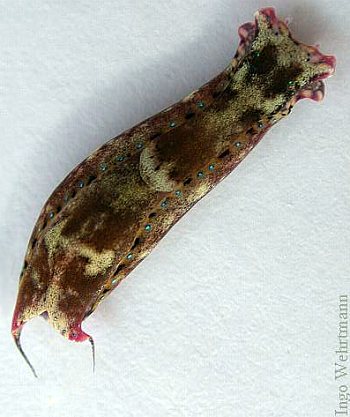
Dear Bill,
Here is a Navanax aenigmaticus from Las Islas Murcielago on the north western Pacific coast of Costa Rica. You can see the blue spots really nicely. The photo was taken by Ingo Wehrtmann. The Navanax in the photo was found in a tide pool on an island of volcanic origin on April 26, 2002.
I've noticed that quite a few Navanax have one "tail" (I don't know what the correct term is) longer than the other. It seems that in many Navanax the left one is longer. You can't really see it well in this photo, but this guy had a longer left tail than right as well. Is there some reason for this that you know of?
Take care,
Peter Ajtai.
ajtai@slugophile.org
Ajtai, P., 2002 (May 25) Navanax aenigmaticus from Costa Rica. [Message in] Sea Slug Forum. Australian Museum, Sydney. Available from http://www.seaslugforum.net/find/7031Dear Peter,
Thanks for the photo. 'Tails' is a s good a name as any for the posterior outgrowths. They are even more pronounced in species of the related genus Chelidonura - the name meaning claw-like or chelae-like tail. In most species the left tail is longer than the right, but I no of no functional reason for this. Just one of life's little mysteries.
Best wishes,
Bill Rudman
Feeding behaviour of Navanax aenigmaticus
May 14, 2002
From: Alicia Hermosillo
Dear Dr. Rudman,
I wanted to run by you something I saw Monday May 6th during a night dive at Playa Mismaloya, Bahia de Banderas. A small Navanax aenigmaticus (12 mm at 23 feet deep) swallowed a smaller Navanax aenigmaticus (7 mm) almost fully only to spit it out a little later. Both animals carried on their ways like nothing had happened.
Has anyone out there seen something like this??
Ali
gueri25@hotmail.com
Hermosillo, A., 2002 (May 14) Feeding behaviour of Navanax aenigmaticus. [Message in] Sea Slug Forum. Australian Museum, Sydney. Available from http://www.seaslugforum.net/find/6934Dear Ali,
I don't know of any studies on the biology of N. aenigmaticus but there are quite a number of studies on the closely related N. inermis which I have listed on that page. Also have a look at Ernie Hartt's earlier message on cannibalism in N. inermis.
Best wishes,
Bill Rudman
Color variation of Navanax aenigmaticus
March 9, 2002
From: Alicia Hermosillo
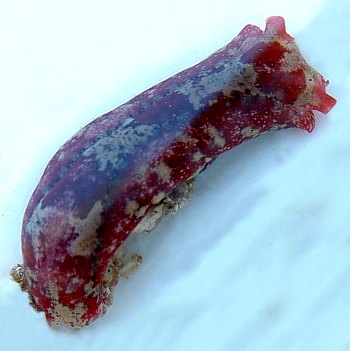
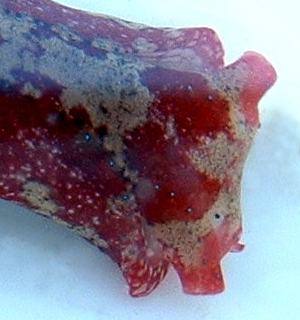
I took these pictures yesterday of this Navanax aenigmaticus. As you can see, the pink-red color is very different from the usual brown or clear pink seen in most pictures. I did also see the yellow ink as I moved it to take the picture. This particular individual I put back after the photo.
Locality data: Los Arcos, Bahia de Banderas, State of Jalisco and Nayarit, Mexico, February 2002.
Alicia Hermosillo
gueri25@hotmail.com
Hermosillo, A., 2002 (Mar 9) Color variation of Navanax aenigmaticus. [Message in] Sea Slug Forum. Australian Museum, Sydney. Available from http://www.seaslugforum.net/find/6317Dear Alicia,
Thanks for this photo. It is certainly an interesting colour variety.
Bill Rudman
Ink from Navanax aenigmaticus
June 9, 2001
From: Elianny Domínguez Tejo
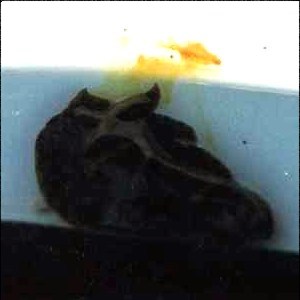
Dear Bill,
This is something new for us. I was trying to get a good picture of Navanax aenigmaticus, but she/he wasn't in the mood. The animal was crawling all over the tray and it was high noon, with the sun bright and hot over me, so I was about to faint.
I took a little wood stick and I tried to move the animal away from the edge of the tray (which obviously I didn't do) and as you can see in the picture, a dark yellow ink came out of the little fellow (from the posterior end, I think). It's just like the purple ink of Bursatella and Aplysia.
I took a very fast picture of the moment, and pray the photo was a good one. Then I figure the yellow ink meant “women, leave me alone all ready”, so I did.
The animal was found on a rocky shore, at 10 cm of depth, in the Caribbean coast of Colombia, and it is 2.5 cm long.
Cheers,
Elianny Domínguez Tejo.
elicelotte@latinmail.com
Domínguez, E., 2001 (Jun 9) Ink from Navanax aenigmaticus. [Message in] Sea Slug Forum. Australian Museum, Sydney. Available from http://www.seaslugforum.net/find/4524Dear Elianny,
This is a very interesting photo. It is the first time I have seen a photo of this yellow ink. I first noticed this yellow secretion in species of aglajid I was studying in New Zealand (Rudman, 1972) and called the gland that produced it the Yellow Gland to match the Purple Gland of the Sea Hares.
I have prepared a page on the Yellow Gland. have a look there for more information.
• Rudman, W.B. (1972) On Melanochlamys Cheeseman, 1881, a genus of the Aglajidae (Opisthobranchia: Gastropoda). Pacific Science, 26(1): 50-62.
Although the photo is not what you planned, it is very valuable
Best wishes,
Bill Rudman
Navanax inermis in Brazil?
February 20, 2001
From: André Mazeron
Hi everyone.
I'm trying to identify a nudibranch I've seen during a dive in Florianópolis, south of Brazil. Searching the web, I've found some pictures of Navanax inermis, and it looks like the same nudibranch I saw. Although this site doesn't mention their presence in south Atlantic, could it be Navanax inermis?
Florianópolis is about latitude 29s. Date of observation was 01/14/2001, at about 14m deep, in a rocky area by a group of islands, not far from the coast.
Best wishes,
André.
mazeron@in.gov.br
Mazeron, A., 2001 (Feb 20) Navanax inermis in Brazil?. [Message in] Sea Slug Forum. Australian Museum, Sydney. Available from http://www.seaslugforum.net/find/3830Dear André,
I'm afraid I can only make a guess without a photo, but what you have most likely seen is Navanax aenigmaticus, which has been recorded from as far south as Sao Paulo, Brasil [as Aglaja evelinae].
Have a look at the photo of Navanax aenigmaticus at the top of this page. If you gave a photo it would be an interesting addition to the Forum. By the way, Navanax is not a nudibranch, it belongs to the Order Cephalaspidea, commonly known as 'Bubble Shells'. The nudibranchs belong to the Order Nudibranchia. Both the Nudibranchia and Cephalaspidea are opisthobranchs or sea slugs. Have a look at the Species List to get an idea of the relationships and diversity within the Opisthobranchia.
Best wishes,
Bill Rudman
Navanax aenigmaticus synonymous?
February 5, 2001
From: Phanor Montoya
Hi Bill!
I hope you had a nice Christmas and the New Year came with happiness. I have question to ask:
Are Chelidonura evelinae, Aglaja evelinae and Navanax aenigmaticus synonymous? I found that the first two were considered by Marcus (1976) as same species; also C. evelinae and N. aenigmaticus are synonymous. So, could I think that the three species are the same, so far?
Thanks
Phanor Montoya
phamont@eudoramail.com
Montoya, P., 2001 (Feb 5) Navanax aenigmaticus synonymous?. [Message in] Sea Slug Forum. Australian Museum, Sydney. Available from http://www.seaslugforum.net/find/3712Dear Phanor,
Yes the names are all synonyms, and Bergh's name Navanax aenigmaticus is by far the oldest
Bill Rudman
Information on Navanax aenigmaticus
January 21, 2001
From: alecia
Hi,
Can you please tell me where I may find more info on the Navanax aenigmaticus? I am looking for everything possible, what they feed on, how long they can be kept in tanks and how?
thank you,
Alecia
heufes@uni-muenster.de
alecia, 2001 (Jan 21) Information on Navanax aenigmaticus. [Message in] Sea Slug Forum. Australian Museum, Sydney. Available from http://www.seaslugforum.net/find/3576Dear Alecia,
Have a look at the top of this page for the only information I know that is available on this species. There is quite a number of studies on the behaviour and ecology of its close relative Navanax inermis. Have a look at that species page for references.
best wishes,
Bill Rudman
Navanax aenigmaticus from Colombia.
October 3, 2000
From: Phanor Montoya

This Cephalaspid is Navanax aenigmaticus I'm sure of that! Found on a shallow rocky area under a rock (Santa Marta, Colombia).
Length 1.5-2 cm.
Phanor
phamont@eudoramail.com
Montoya, P., 2000 (Oct 3) Navanax aenigmaticus from Colombia.. [Message in] Sea Slug Forum. Australian Museum, Sydney. Available from http://www.seaslugforum.net/find/3101Dear Phanor,
Yes, this is indeed N. aenigmaticus. Although this species was originally described from the Pacific Coast of central America, Terry Gosliner (1980) could find no morphological reasons to separate specimens from the Caribbean.
I've tried to show the characteristic blue spots along the parapodial edge (arrows) but although I can see them clearly in your original image file, I'm afraid they disappear when I put the photo on the web.
Best wishes,
Bill Rudman.
